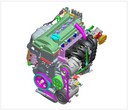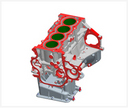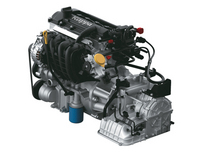Hyundai Develops New Fuel-Saving Kappa Engine - VIDEO ENHANCED
• Innovative technologies cut weight and friction to boost fuel economy
–
• 5.0L/100km (47 mpg) in the European combined test cycle –
• Lowest CO2 in its class: just 119g/km –
• Lightest dry weight in its class: just 82.4kg –
• To be installed on Hyundai i10, i20 A– and B–segment cars –
• Kappa engine plant opens in Chennai, India
SEOUL - July 18, 2008: In an era of soaring gasoline prices, Hyundai Motor Co. is helping frugal–minded drivers meet the challenge of affordable transportation with its newly developed Kappa engine.
"The world is thinking small like never before: Smaller fuel consumption, smaller CO2 footprint, smaller overall emissions. Today small is beautiful and Hyundai is ready to answer the call to small with our new Kappa inline four cylinder engine," said President and Chief Technology Officer Lee Hyun–Soon.
 Hyundai i10 |
Click PLAY to watch short video clip of the i10 introduction in Barcelona
Hyundai´s i10 minicar with a 1.25 liter Kappa engine will deliver a fuel economy rating of 5.0L/100km (47 mpg) in the European combined test cycle––for best in class performance. And Kappa runs cleaner than the competition: In the European combined test cycle, an i10 equipped with the Kappa engine produces just 119g/km of CO2–far less than the Fiat Panda, Fiat Punto, Opel Corsa, Renault Twingo and Nissan Micra.
Kappa also impresses with its high specific torque rating of 9.6kg.m per liter––best in class––for excellent drivability in stop–and–go city traffic. Kappa will also be installed in Hyundai´s i20 due to be revealed at this autumn´s Paris Auto Show.
 |
Kappa puts out 77.8ps@6000rpm––very competitive within the European A–segment––but peak torque is rated best–in–class at 12.0kg.m per 4000rpm––ensuring outstanding acceleration and driving enjoyment.
Kappa adopts a number of weight and friction reducing innovations to achieve its impressive fuel economy.
First, the engine block is made from high pressure die–cast aluminum which results in considerable weight savings: Weighing a mere 82.4kg (1.2 with manual gearbox)?Kappa is the lightest in its class among leading European and Japanese–made engines (using the same measuring criteria across the competitive set).
 |
But probably the most significant engineering innovation is Kappa´s offset crankshaft, an engineering concept first adopted in the Gamma engine introduced last year.
 |
Engineers also devised an innovative piston concept to reduce piston mass. The shape of the piston skirt was optimized to reduce its size while the compression height of the piston was also reduced, resulting in precious weight savings.
The optimized piston skirt is also treated with Molybdenum Disulfide (MoS2), a special anti–friction coating.
A highly sophisticated process of Physical Vapor Deposition (PVD) is used to apply an ultra–thin layer of chromium nitride (CrN) to the piston´s oil ring. CrN ensures high wear resistance and a low friction coefficient. CrN–coated piston rings using PVD is an innovative technology borrowed from the Tau V8 engine that Hyundai introduced earlier this year. Friction between the oil ring and cylinder wall has been further minimized by reducing the oil ring tension. The smaller mass and special surface treatment of the piston skirt and oil rings yielded additional savings in fuel consumption.
Kappa is the first Hyundai engine to be fitted with an accessory drive belt which does not require a mechanical auto–tensioning adjustment device, reducing the hardware and further lowering weight and cost. Because it is designed to maintain an ideal tension setting, the belt runs quieter and with proper preventative maintenance and care, the belt will last 100,000 miles.
 |
The long reach spark plug (M12 thread) also enabled engineers to enlarge the valve diameter for increased airflow and combustion efficiency.
Kappa´s valvetrain features a number of innovations: roller swing arm lowers friction in the valvetrain thereby helping improve fuel efficiency. Hydraulic lash adjusters ensure clearances between the valve stem and roller swing arm are always perfect: zero, eliminating valve tapping noise.
A new valve spring features an innovative beehive shape and smaller retainer. Its reduced weight and spring load help lower friction and improve fuel economy.
Kappa´s valvetrain is driven by a silent–type steel timing chain that replaces roller–type timing chain: The optimized design greatly reduces impact forces and noise when the gear tooth and chain engage. Moreover, the chain requires absolutely no maintenance.
A lightweight, heat–resistant engineering plastic was specified for the intake manifold. This reduces cost and weight and yields an overall performance improvement.
The fuel delivery pipe assembly is a returnless type (to eliminate evaporative fuel emissions) and is made of SUS (steel use stainless) with an innovative inner structure for the reduction of pulsation noise.
Kappa is controlled by two 16–bit 32Mhz microprocessors for digitally precise control of the ignition timing, idle speed, knocking and emissions.
Kappa is the eleventh in its series of gasoline engines to be independently developed with Hyundai technology. The development story began in 1991 with the introduction of Hyundai´s first proprietary engine, the four–cylinder Alpha (see list below). Kappa will be manufactured in two variants 1.25 litres (EU) and 1.2 litres (Indian market only) at HMI´s No. 2 engine plant, where annual output is forecast to reach 250,000 units per year. With the newly–constructed No. 2 Kappa engine plant, HMI will have a total engine manufacturing capacity of 570,000 units per year, including the existing 320,000 units–per–year No. 1 Epsilon and Alpha engine plant. The Kappa engine plant begins production today (July 15).



